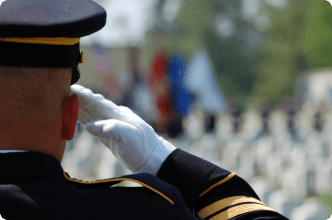Access Free VA Claims Assistance

Free Cancer Guide for Veterans

Find a Top Mesothelioma Doctor

Members of the military and their families are at high risk of asbestos exposure — the main risk factor for mesothelioma. Marines who were exposed to asbestos during their military service and later developed an asbestos-related illness may be eligible for VA disability benefits.

The Veterans Administration provides support for veterans, including disability compensation, medical care and many other services. Veterans who served honorably, were exposed to asbestos during their military service and developed an asbestos-related illness may be eligible for VA medical benefits and disability compensation.
If you served in the U.S. Marine Corps, you likely had occupational exposure to asbestos in buildings, armored vehicles and Navy ships. If you developed mesothelioma, asbestosis or another asbestos-related condition after your military asbestos exposure, then it may qualify as a service-connected disability. Having a service-connected disability qualifies you for certain VA benefits.
Disability compensation is based on your level of disability. Pleural mesothelioma, peritoneal mesothelioma, lung cancers, asbestosis and chronic asbestos-related conditions can receive a disability rating of 100% in most cases. This means that you will qualify for full medical benefits and the highest possible monthly disability payment.
To file a VA disability claim, you need to fill out paperwork and provide supporting information for your claim. Gather as much information as possible about your medical history and be prepared to give the VA access to your medical records to help with your claim. In your claim, you should list all known health problems that may be related to military service, not just asbestos-related conditions.
Filing claims with the VA can be a tedious and frustrating experience, but The Mesothelioma Center has a veteran’s department specializing in VA claims. These experienced patient advocates will work with you and guide you every step of the way. The full process can take months to complete, so you should start your claim as soon as possible.
Once a claim is submitted, it takes the VA about one month to contact you. The VA may ask for additional information and set up free medical appointments with VA-contracted doctors to evaluate you. The VA will use these medical evaluations, along with your military record and past medical records, to decide if you have a service-connected disability.
Final decisions from the VA can take five to eight months, but they will take much longer if you delay your medical appointments. If you’re eligible for compensation, you’ll get back pay starting from when you first filed your claim.
Access Free VA Claims Assistance

Free Cancer Guide for Veterans

Find a Top Mesothelioma Doctor

The VA has medical centers and clinics throughout the country. Some large VA medical centers are designated mesothelioma treatment centers that specialize in diagnosing mesothelioma and its treatment. There are five of these centers in large population centers across the country.
Getting care at a VA mesothelioma center gives you access to medical professionals who specialize in mesothelioma. Most physicians have little to no experience with mesothelioma. Having an experienced team of health care providers who work together is essential for getting the best possible care.
People who don’t live near a VA facility may need to travel long distances for appointments. Most veterans are eligible for VA travel pay reimbursement for travel expenses. This can include food and lodging. However, travel arrangements must be VA-approved. Reimbursement is available for VA-scheduled claims appointments regardless of whether your claim is approved.
Members of the Marine Corps have historically been at increased risk of developing mesothelioma. The key risk factor for developing this malignant cancer is prolonged and significant asbestos exposure. Marines have worked in high-risk environments, particularly on Navy ships that used asbestos throughout.
Marine veteran and action film star Steve McQueen, for example, developed pleural mesothelioma after serving on naval ships and in shipyards. Studies find high mesothelioma rates among all occupations on ships with some suggesting marine engineers have particularly high risk.
I’m an ex-Marine and I’ve already beaten the odds. I was given six months to a year to live six years ago. It’s important that people understand there is hope.David CuttsMarine Corps Veteran
The prognosis for mesothelioma is generally poor, however, the future of cancer treatment presents opportunities for patients. It’s important to remember that everyone is unique and responds to treatment differently.
Marines and sailors serving on older ships have historically had significantly high levels of asbestos exposure, living and working around asbestos around the clock while at sea. The more time you have spent at sea, the higher your overall asbestos exposure.
Asbestos was used extensively throughout all types of military ships, aircraft and armored vehicles. Working in vessels or vehicles made with asbestos can lead to dangerous occupational asbestos exposure. Old parts, equipment and facilities may still pose asbestos exposure risks to those currently serving.
Members of the Marine Corps and their families are at high risk for asbestos exposure on Marine bases around the world. Military barracks and on-base family housing built before the 1980s extensively used asbestos in their construction. Working or living in these buildings can lead to asbestos exposure for service members and their families.

People working in demolition or asbestos abatement in older buildings on military bases are at high risk of asbestos exposure. When material containing asbestos is disturbed, asbestos fibers can be released. Everything from concrete and flooring to drywall and roofing has been made with asbestos at one time or another.
Family members can also be at risk of developing mesothelioma from secondary asbestos exposure. Marines bringing home uniforms and gear with asbestos fibers on them can expose their loved ones when doing laundry or other types of contact.
Yes, Marine veterans and their survivors can file lawsuits against asbestos manufacturers who supplied materials to the military. Civil lawsuits for mesothelioma can lead to damages paid to veterans or their surviving family members. Lawsuits require the expertise of an experienced mesothelioma lawyer.
The Promise to Address Comprehensive Toxics Act of 2022 expands the number of conditions eligible for VA disability coverage to include combat-related toxic exposures. The PACT Act covers veterans who served in combat in Vietnam, the Gulf War and post–9/11 operations.
PACT makes it easier for people to receive disability benefits for specific medical conditions associated with exposure to toxins such as Agent Orange and burn pits. The VA now presumes that your injury is service connected if you were exposed to toxins in a combat zone. This can make it easier to get a VA claim approved for conditions that can develop many years after military service, including any type of lung cancer.
In recent years, the U.S. government has recognized that people stationed at MCB Camp Lejeune and MCAS New River were exposed to toxic chemicals in the water on base. This has led to expanded VA disability coverage for anyone stationed at these locations from the 1950s through the 1980s, similar to the PACT Act.
While asbestos was used extensively at Camp Lejeune — including asbestos-coated pipes — there is no evidence that toxins in the water are related to asbestos exposure. The chemicals found in the water are associated with a variety of medical conditions, but not mesothelioma or lung cancers. In other words, you may have been exposed to asbestos at Camp Lejeune but not through the drinking water.
Your web browser is no longer supported by Microsoft. Update your browser for more security, speed and compatibility.
If you are looking for mesothelioma support, please contact our Patient Advocates at (855) 404-4592
The Mesothelioma Center at Asbestos.com has provided patients and their loved ones the most updated and reliable information on mesothelioma and asbestos exposure since 2006.
Our team of Patient Advocates includes a medical doctor, a registered nurse, health services administrators, veterans, VA-accredited Claims Agents, an oncology patient navigator and hospice care expert. Their combined expertise means we help any mesothelioma patient or loved one through every step of their cancer journey.
More than 30 contributors, including mesothelioma doctors, survivors, health care professionals and other experts, have peer-reviewed our website and written unique research-driven articles to ensure you get the highest-quality medical and health information.
My family has only the highest compliment for the assistance and support that we received from The Mesothelioma Center. This is a staff of compassionate and knowledgeable individuals who respect what your family is experiencing and who go the extra mile to make an unfortunate diagnosis less stressful. Information and assistance were provided by The Mesothelioma Center at no cost to our family.LashawnMesothelioma patient’s daughter


Munz, A. (2024, November 5). Marine Veterans. Asbestos.com. Retrieved July 8, 2025, from https://www.asbestos.com/veterans/marines/
Munz, Aaron. "Marine Veterans." Asbestos.com, 5 Nov 2024, https://www.asbestos.com/veterans/marines/.
Munz, Aaron. "Marine Veterans." Asbestos.com. Last modified November 5, 2024. https://www.asbestos.com/veterans/marines/.
A United States military veteran with knowledge of asbestos exposure reviewed the content on this page to ensure it meets current standards and accuracy.
Retired Culinary Specialist and Senior Chief Nathan Pinner uses his extensive naval leadership, including service at the White House, to better serve other veterans.
Our fact-checking process begins with a thorough review of all sources to ensure they are high quality. Then we cross-check the facts with original medical or scientific reports published by those sources, or we validate the facts with reputable news organizations, medical and scientific experts and other health experts. Each page includes all sources for full transparency.
Please read our editorial guidelines to learn more about our content creation and review process.
